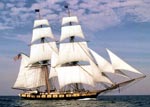
The Brig not the Brigantine Niagara
There was an amusing bit of bantering and ballyhooing about ship jargon in the New York Times yesterday. In an article about the remains of ship found in the excavation near the new World Trade Center (see our previous posts here) The Gudgeon Did It: A Small Detail Settles a Maritime Mystery, David Dunlop explains that until archaeologists identified the gudgeon, they weren’t sure which end of the ship was which. Dunlop then, somewhat gleefully, notes that “thirty-six years in this business, and never before have I had the chance to use the words gudgeon and pintle in an article.” So far, so good. Then the argument broke out.
It seems that Dr. Warren Riess had speculated that ship was “most likely a brigantine.” Unfortunately, in a slide show he presented, he showed a photograph of the brig Niagara. The Times also printed the photo. Stern and outraged e-mails and letters ensued. The New York Times went so far as to post the following correction on the bottom the article:
A picture on July 30 with an article about the unearthing of what is believed to be an 18th-century brigantine in Lower Manhattan was published in error. It showed an example of a brig, which has two square-rigged masts — not a brigantine, on which only the front mast is typically square-rigged. A reader raised the issue in an e-mail message at the time the article was published, but the error was confirmed only after extensive research and much debate.
Of course, the difference between a brig and a brigantine is pretty cut and dried. A brig has at least one square sail on the main mast and a brigantine doesn’t. Nevertheless the overriding question becomes – who cares? Dr. Riess was able to determine that the ship probably had two masts. Based on this and his knowledge of the relative popularity of rigs of the period he opined that it probably was a brigantine. It, of course, could have been a schooner, a snow or a brig. With only one mast step to work with no one can really say too much for sure.
Besides not having many facts to work with, the language itself is pretty flexible. As Dr. Riess notes, “The terms brig and brigantine are a bit squirrelly. While today most people who care strictly distinguish the two, many people like myself, whose research is mostly in the 18th century, rarely make the distinction. In the 18th and early 19th centuries, most people did not make the distinction, or disagreed about it.”
For those who would like to learn more about the remains of the ship, whatever its rig might have been, there will be a discussion of the “Historic Hull on Hallowed Ground” on September 30th at the New York Academy of Sciences featuring Norman Brower, maritime historian with Mystic Seaport; Nicole Doub, archaeologist with the Maryland Archaeological Conservation Laboratory; and Michael Pappalardo, Senior Archaeologist and Technical Director at AKRF. The discussion will be moderated by Dr. Brian Ferguson of Rutgers University-Newark
An Historic Hull on Hallowed Ground: Three Experts Discuss the 200-Year-Old Ship Next Door

If the ship in question had only one mast step it is surely a sloop similar to the Providence, of Rhode Island. For it to be either a brig or a brigantine it would have two mast steps. The sloop rig was a fairly common coater rig at the time of the Revolution.
Coaster, not coater !
Apparently only one mast survived. Roughly half of the ship still exists. The other half was destroyed in an early excavation. Based on the location of the one mast step they found, the archeologists think that she probably had two masts. The mast step would have been too far aft for it likely to have been a sloop, though at this point, everything is an educated guess.
Please can someone define a Snow? I have seen the term in fiction, but not defined/distinguished from other types.
A snow and a brig are very similar rigs. Both have two masts with both masts fully square-rigged. Both have a fore and aft sail termed a trysail or spanker aft of the main mast. The difference between the brig and the snow is in the rigging of the spanker. On a snow there is a small mast abaft the lower main mast to which the trysail is rigged.
Scroll down on the link below to see a sketch of both a brig and a snow.
Rigging a Sailship
Rick, I need some help determining what kind of vessels smugglers used during Jefferson’s Embargo of 1808-09 to get goods back and forth from the West Indies. Would a snow or brig be a logical choice? Any information you could provide would be spectacular! Thanks in advance.